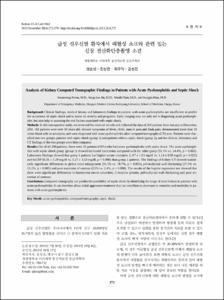KUMEL Repository
1. Journal Papers (연구논문)
1. School of Medicine (의과대학)
Dept. of Emergency Medicine (응급의학)
급성 신우신염 환자에서 패혈성 쇼크와 관련 있는 신장 전산화단층촬영 소견
- Alternative Author(s)
- Jin, Sang Chan; Choi, Woo Ik; Kim, Sung Jin
- Journal Title
- 대한중환자의학회지
- ISSN
- 1229-4802
- Issued Date
- 2013
- Abstract
- Background: Clinical findings, medical history and laboratory findings in patients with acute pyelonephritis are insufficient to predict
the occurrence of septic shock and to assess its severity and prognosis. Early imaging may not only aid in diagnosing acute pyelonephritis,
but also help in assessing the risk factors associated with septic shock.
Methods: In this retrospective study, we reviewed the medical records and collected the data of 200 patients from January to December,
2011. All patients were over 18 years old; showed symptoms of fever, chills, muscle pain and flank pain; demonstrated more than 10
white blood cells in urinalysis; and were diagnosed with acute pyelonephritis after computed tomography (CT) scan. Patients were classified
into two groups: patients with septic shock (group 1) and patients without septic shock (group 2), and the clinical, laboratory and
CT findings of the two groups were then compared.
Results: Out of all 200 patients, there were 32 patients (16%) who had acute pyelonephritis with septic shock. The acute pyelonephritis
with septic shock group (group 1) showed increased bacteremia compared with the other group (53.1% vs. 24.4%, p = 0.002).
Laboratory findings showed that group 1 patients had higher serum creatinine (1.67 ± 1.03 mg/dl vs. 1.14 ± 0.98 mg/dl, p = 0.022)
and hsCRP (8.36 ± 5.29 mg/dl vs. 5.27 ± 3.53 mg/dl, p = 0.000) than group 2 patients. The findings of kidney CT showed statistically
significant differences in global renal enlargement (31.3% vs. 18.7%, p = 0.005), pelvicalyceal wall thickening (37.5% vs.
13.1%, p = 0.005) and poor excretion of contrast (25% vs. 2.4%, p = 0.000). The results of the logistic regression test showed that
there were significant differences in bacteremia serum creatinine, C-reactive protein, pelvicalyceal wall thickening and poor excretion
of contrast.
Conclusions: Computed tomography can predict the possibility of septic shock by identifying the range of renal lesions in patients with
acute pyelonephritis. It can therefore allow initial aggressive treatment that can contribute to decreases in mortality and morbidity in patients
with acute pyelonephritis.
- Alternative Title
- Analysis of Kidney Computed Tomographic Findings in Patients with Acute Pyelonephritis and Septic Shock
- Department
- Dept. of Emergency Medicine (응급의학)
- Publisher
- School of Medicine
- Citation
- 권순성 et al. (2013). 급성 신우신염 환자에서 패혈성 쇼크와 관련 있는
신장 전산화단층촬영 소견. 대한중환자의학회지, 28(4), 272–279. doi: 10.4266/kjccm.2013.28.4.272
- Type
- Article
- ISSN
- 1229-4802
- Appears in Collections:
- 1. School of Medicine (의과대학) > Dept. of Emergency Medicine (응급의학)
- 파일 목록
-
-
Download
 oak-bbb-3680.pdf
기타 데이터 / 670.63 kB / Adobe PDF
oak-bbb-3680.pdf
기타 데이터 / 670.63 kB / Adobe PDF
-
Items in Repository are protected by copyright, with all rights reserved, unless otherwise indicated.